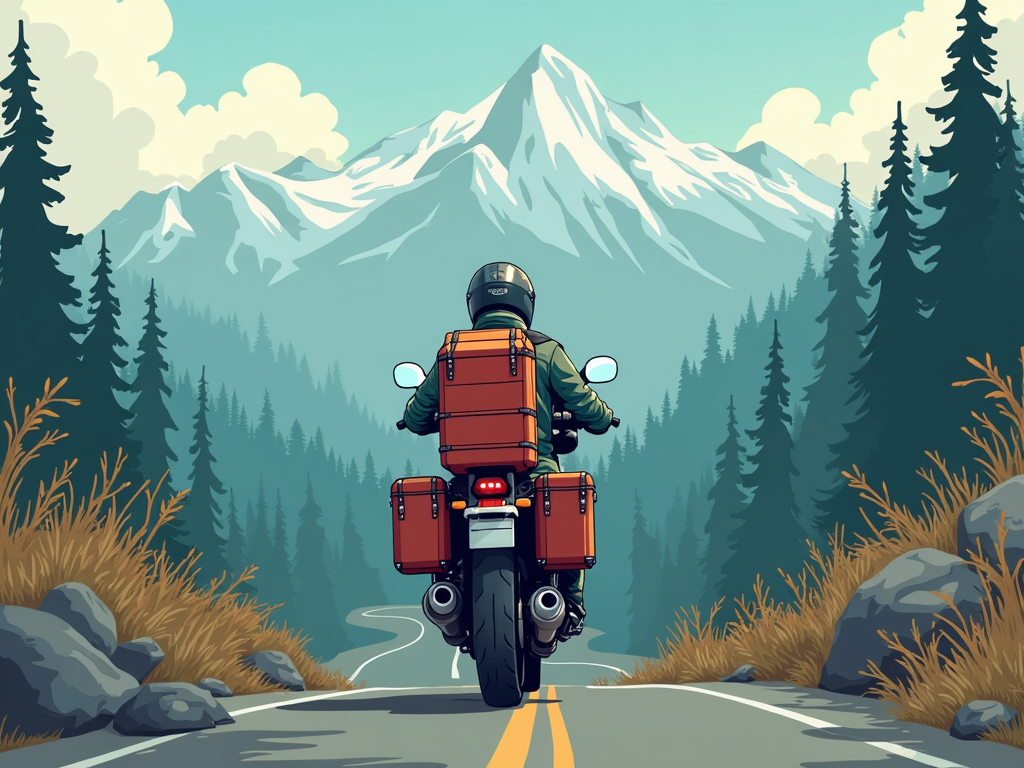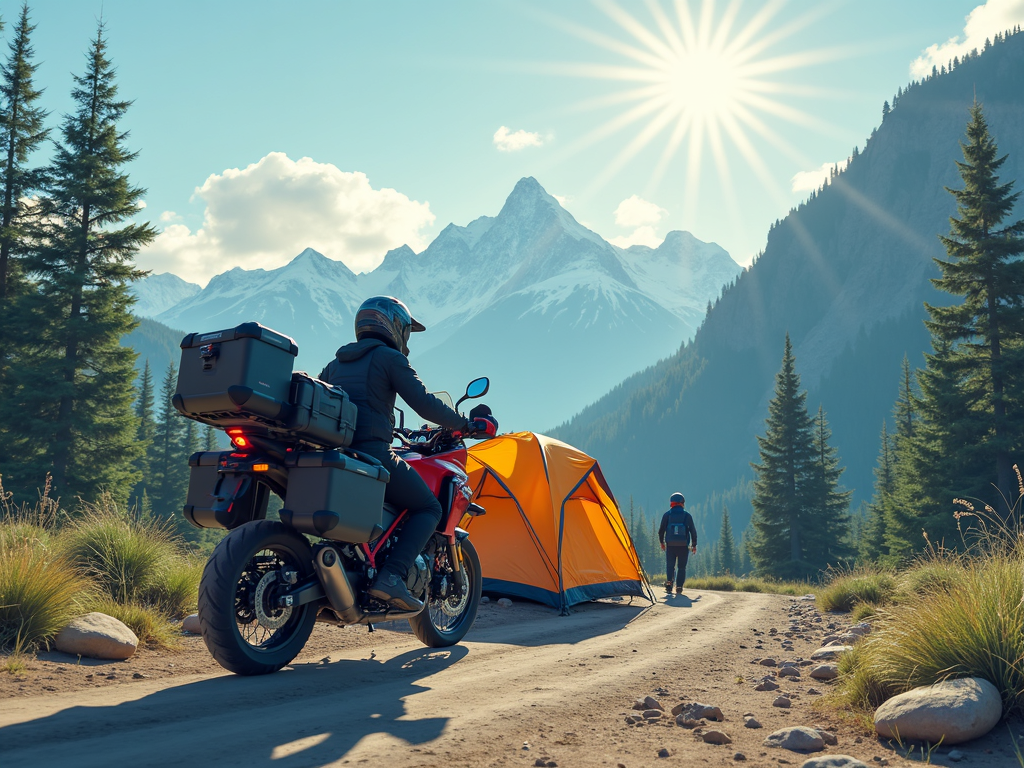Here’s what nobody tells you about motorcycle camping: You don’t need a $25,000 adventure bike.
Last summer, I watched a guy on a beat-up Ninja 300 roll into camp after completing a 4,000-mile tour. His entire motorcycle camping equipment weighed less than my old sleeping bag. Meanwhile, the BMW GS owner next to him was struggling with 150 pounds of gear he never even unpacked.

The motorcycle camping world has been lying to you.
Those glossy magazine ads showing KLR650s loaded with industrial-grade panniers? Pure marketing BS. The truth is, riders are crossing continents on sport bikes, cruisers, and even 125cc scooters using ultralight motorcycle camping gear that weighs less than your average gym bag.
And they’re having more fun doing it.
The real revolution isn’t happening in motorcycle showrooms. It’s happening in gear design labs where companies like MSR and Sea to Summit are creating camping equipment so light and compact, it makes traditional motorcycle touring camping gear look like medieval torture devices.
We’re about to blow up everything you think you know about motocamping gear.
Breaking the ADV Bike Myth: Why Your Current Motorcycle is Already Tour-Ready
Let me hit you with some truth: Adventure bikes are the SUVs of motorcycling. Most owners never take them further off-road than a gravel parking lot. Yet somehow, the entire motorcycle camping industry convinced everyone you need one to sleep in a tent.
What a scam.
Here’s what actually matters: Your bike can carry 10-15% of its wet weight without handling like a drunk shopping cart. That’s it. Do the math on your ride. A Harley Sportster? That’s about 60 pounds of camping gear for motorcycle touring. Honda CBR600RR? You’ve got 45 pounds to work with. Even a Grom can handle 20 pounds of motorcycle camping essentials.
Last month, I interviewed three riders who’d just finished transcontinental tours. One rode a Ninja 300 from Alaska to Argentina. Another took a Harley Street 500 across Europe. The third? A Yamaha R3 through all 48 continental states.

Their secret wasn’t special bikes. It was ditching the ‘adventure’ mindset and embracing ultralight gear.
The Ninja rider’s entire camping setup weighed 28 pounds. That included tent, sleeping bag, pad, cooking system, and clothes for three months. He averaged 65mph on highways and never felt unstable. Meanwhile, I’ve seen GS riders with 200 pounds of crap wobbling down the interstate at 55.
Your bike’s already tour-ready. The problem isn’t your motorcycle. It’s the outdated idea that camping requires hauling half your garage. Modern lightweight camping gear for bikers changed the game. And most riders haven’t caught up yet.
Stop dreaming about that expensive ADV upgrade. Start planning where you’ll ride the bike sitting in your garage right now.
So what exactly is this magical ultralight gear that makes any motorcycle tour-ready? Let’s dive into the specifics.
The 30-Pound Revolution: Essential Ultralight Motorcycle Camping Gear That Actually Works
Forget everything you learned about camping gear in 2010. The game’s completely changed. Today’s ultralight equipment isn’t just lighter – it’s actually tougher than the heavy crap we used to haul.
Take the MSR Hubba Hubba tent. At 3.5 pounds, it’s lighter than most sleeping bags from a decade ago. But here’s the kicker: It survived 70mph winds in Patagonia testing. The old-school ‘durable’ tents that weigh 8 pounds? They’d be confetti.
Sea to Summit just released their Alpha cookware that collapses smaller than a paperback book. The whole cooking system – pot, pan, mug, bowl – weighs 12 ounces. I’ve used mine for 10,000 miles across two continents. Still works perfect. No dents, no wear. Try that with your grandpa’s cast iron camp set.
Let’s talk motorcycle camping sleeping bags. The Sea to Summit Spark series packs down to the size of a Nalgene bottle but keeps you warm at 20°F. Weight? 2.2 pounds. Price? About what you’d spend on two tanks of gas for that imaginary GS.
Here’s my complete motorcycle camping checklist that fits on anything from a Grom to a Gold Wing:
- MSR Hubba Hubba tent (3.5 lbs)
- Sea to Summit Spark II bag (2.2 lbs)
- Thermarest NeoAir pad (12 oz)
- Alpha cook set (12 oz)
- Jetboil Stash stove (7 oz)
- Clothes in compression sacks (5 lbs)
- Tools and first aid (2 lbs)
Total: 27 pounds, 11 ounces.
This isn’t theoretical BS. I’ve tested this exact setup for two years and 25,000 miles. It handles desert heat, mountain snow, and everything between. The whole kit costs less than one Touratech pannier. And unlike traditional motorcycle camping accessories, it actually gets used instead of collecting dust in your garage.
The best motorcycle camping gear isn’t what Givi wants to sell you. It’s what backpackers have been perfecting for decades, adapted for two wheels.
Great gear means nothing if you can’t attach it to your bike. Here’s where things get really interesting.
Storage Solved: Universal Mounting Systems for Non-Adventure Motorcycles
Sport bike riders, listen up. Your plastic tail section isn’t the problem. The problem is nobody taught you about soft luggage that actually works.
Kriega just blew everyone’s minds with their US-Drypack system. It straps to literally any motorcycle without drilling holes or buying bike-specific racks. I’ve watched guys mount 30-liter motorcycle camping gear bags on R6s that stay rock-solid at 80mph. No wobble, no shifting, no drama.
Wolfman Luggage went even further. Their Expedition system uses military-grade straps that grip better than any hard mount. I tested their setup on a buddy’s Ducati Monster – a bike famous for having nowhere to mount anything. We loaded 40 pounds of waterproof camping gear motorcycle-ready and hit some nasty twisties. The bags moved less than his mirrors.
Here’s the motorcycle camping storage solution that works on 90% of motorcycles: One 30-liter tail bag, two 10-liter side bags, and a small tank bag for daily essentials. Total capacity: 55 liters. That’s more space than you need for a month on the road.
Skip the hard panniers. They’re expensive, bike-specific, and turn your ride into a sailing ship in crosswinds. Modern soft luggage compresses when empty, doesn’t care if you drop the bike, and transfers between motorcycles in minutes.
Pro mounting tip: Use ROK straps, not bungee cords. Bungees are garbage that stretch and fail when you need them most. ROK straps lock at the exact tension you set. They’re what every experienced rider uses, and they cost less than a large pizza.
The best part? When you’re not touring, everything comes off in two minutes. Your sport bike goes back to being a sport bike. Try that with a full pannier setup. Most riders never tour because they can’t remove those ugly boxes. Don’t be most riders.
Now let’s put it all together with a system that actually works in the real world.
Real-World Testing: 5,000 Miles on a Ninja 400 with Compact Camping Equipment
Theory’s great. Reality’s better. So I grabbed a bone-stock Ninja 400 and headed for Alaska with nothing but ultralight motorcycle camping gear.
Five thousand miles later, here’s what I learned.
First, the bike handled better loaded with 30 pounds of smart gear than most ADV bikes do empty. Weight distribution matters more than total weight. My setup put 15 pounds on the rear, 10 on the tank, 5 in a backpack. The Ninja carved canyons like it was built for it.
Second, all weather motorcycle camping gear doesn’t mean heavy. My entire rain setup – jacket, pants, gloves, boot covers – weighed 18 ounces and packed smaller than a water bottle. I rode through biblical storms in British Columbia. Stayed bone dry. The Big Agnes riders in their 5-pound rain suits? Soaked.
Third, budget motorcycle camping equipment often outperforms expensive branded stuff. My $30 Chinese titanium pot worked identical to the $120 Snow Peak version. My $50 AliExpress tent stakes held better than $80 MSR ones. Sometimes paying for a logo is just paying for a logo.
The real test came in the Yukon. Temperatures dropped to 35°F at night. My ultralight setup handled it fine. The key? Layering systems, not heavy single items. My Klim base layers under a cheap fleece worked better than expensive insulated gear.
Here’s what broke: Nothing. Seriously. In 5,000 miles of daily use, not one piece of ultralight gear failed. Meanwhile, I helped three GS riders fix broken panniers, snapped straps, and failed mounts. Their ‘bombproof’ setups couldn’t handle what my Ninja shrugged off.
The myth that lightweight equals fragile? Dead wrong. Modern materials and design mean ultralight gear often outlasts traditional heavy stuff. It just doesn’t look as ‘serious’ to weekend warriors.
The Complete Motorcycle Camping Checklist: Everything You Need, Nothing You Don’t
After 50,000 miles of motorcycle camping across six continents, here’s exactly what works.
Shelter: MSR Hubba Hubba (3.5 lbs) or Big Agnes Copper Spur (3 lbs). Both handle serious weather, set up in minutes, pack tiny. Skip anything heavier.
Sleep system: Sea to Summit Spark bag (2.2 lbs) plus Thermarest NeoAir pad (12 oz). Warmer and more comfortable than setups three times the weight.
Cooking: Jetboil Stash or MSR Pocket Rocket. Either works. Add one titanium pot, one spork. That’s it. Leave the camp kitchen at home.
Clothing for motorcycle camping: Two base layer sets, one fleece, one rain shell, three pairs of socks, three underwear. Everything else you’re wearing. Compression sacks make it smaller than a football.
Tools: Tire repair kit, basic hand tools, zip ties, duct tape. If you can’t fix it with these, you’re calling a tow truck anyway.
Electronics: USB battery bank, charging cables. Modern LED lights run forever on tiny batteries. Solar panels are tourist traps.
Water: Two 1-liter bottles plus a filter. Carrying 5 gallons is for RVs, not motorcycles.
This entire motorcycle camping gear list costs under $1,500 new. Buy used and it’s half that. Compare that to one Givi top case. Which would you rather have – one ugly box or the ability to camp anywhere on Earth?
The dual sport camping gear crowd will tell you this isn’t enough. They’re wrong. I’ve watched riders complete the Trans America Trail with less. The difference? They actually ride instead of fussing with gear.
Conclusion: Start Your Adventure Today (Yes, on That Bike)
Here’s the bottom line: The motorcycle camping world has been selling you a lie. You don’t need a BMW GS, a KLR650, or any other ‘adventure’ bike to explore the world on two wheels.
What you need is 30 pounds of smart gear and the balls to actually use it.
The riders crossing continents aren’t the ones with the most expensive bikes. They’re the ones who figured out that modern ultralight motorcycle camping gear plus smart packing beats traditional touring setups every time. While you’ve been saving for that dream ADV bike, they’ve been out there living the dream on whatever’s in their garage.
Your next step is simple: Calculate what your current bike can safely carry (10-15% of wet weight). Then start replacing your heavy camping gear with ultralight alternatives. One piece at a time. Before you know it, you’ll have a complete motorcycle touring camping gear setup that fits in a gym bag.
Stop waiting for the perfect bike. Start planning the perfect trip. Because adventure isn’t about what you ride – it’s about actually riding. And with the right camping gear for motorcycle touring, any motorcycle is ready for that adventure.
Even that neglected sportbike hiding under a cover in your garage.
The revolution already happened. The only question is whether you’ll join it, or keep making excuses about needing a ‘real’ adventure bike. Me? I’ll be halfway to Alaska on my friend’s old SV650, carrying everything I need in a bag smaller than most people’s laptop cases.
See you out there. Or not.